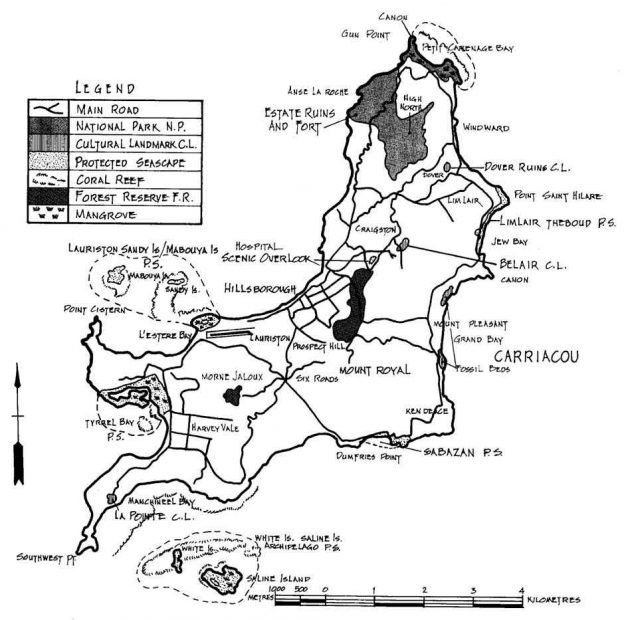High North and the national park on Carriacou.
High Point North: At 955 feet above sea level this is the highest point in Carriacou.
This national park encompasses the complete spectrum of ecological systems in Carriacou.
It includes L’Anse La Roche, the most scenic and private beach in Carriacou, where coral reefs and outstanding volcanic and uplifted sedimentary formations are clearly visible.
The littoral vegetation of seagrape, manchineel and coconut is well developed.
The park is the most undisturbed area of Carriacou.
The park is the setting for the Maroon Cultural Festival and Parang Festival.
Both French and English ruins of plantation buildings and well-preserved windmills.
A network of hiking trails, natural scenery, including a teak and mahogany forest and wildlife.
Carriacou Fossil Beds:
The fossil beds at Grand Bay are the only known beds in the country which are plainly visible.
They provide excellent information.
Exposing millions of years of archeaeology in the rock layers.
Including prehistoric shellfish, some of which are long since extinct.
Shore birds can be seen searching for crustaceans in the mudflats of the lagoon.
The adjacent coral reefs are unquestionably this nations finest.
Panoramic views of the reefs may be seen from various lookout points on both Saline and White Island.
Belair National Park on Carriacou.
Belair National Park offers fabulous views over the north of the island and beyond Petite Martinique.
The windmills that you come across were mainly used for sugar cane crushing.
Others may have been used in the lime factories or the processing of cotton.
Belair also has old French and English ruins and the finest sugarmill and windmill foundations on the island.
The national parks on Carriacou and protected areas.
Sandy Island Marine Park Carriacou.
Surrounded by white sands, this tiny island has the most spectacular coral reef, the home of shoals of variated tropical fish, in clear blue water.
Ideal for picnics, this beautiful island has been used for television and magazine advertisements.
Saline Island and White Island Marine Park.
Saline Island and White Island present examples of fascinating geology.
Columnar jointing of the rock formations indicate major volcanic activity.
Saline Island has a brackish lagoon salt pond surrounded by a mangrove ecosystem.
White Island is a marine park because of its virgin reefs, and shoals of exotic tropical fish.
Petit Carenage Bay:
The mangrove ecosystems at Petit Carenage Bay are among the most developed in country.
Both the mangrove swamp formation and littoral sand beach vegetation are found.
This is one of the finest mangrove and mud flat ecosystems.
Here numerous migratory and shorebirds can be found.
The area is one of the best bird-watching spots in the country.
Tyrell Bay oyster beds.
At Tyrell Bay ‘tree oysters’ grow on mangrove roots.
The oyster beds can be visited by boat, and the trail back to L’Esterre is spectacular with wonderful views.
Underwater Study:
The introduction of the ‘Carriacou Islander’, a 35 foot motor powered catamaran, has opened exciting new possibilities for both Carriacou and Petite Martinique.
The 16 x 4 feet underwater observation window, which can be raised and lowered as required has the double advantage of allowing very close views of the tropical reef and fishes while avoiding possible damage to this fragile ecosystem.
There is a library and running commentary, which provides study opportunities for those with a special interest in marine life.
